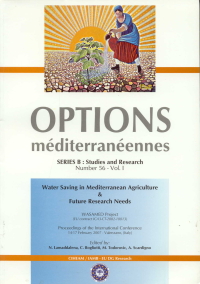| Article précédent | p. 381-396 | Article suivant |
Water saving scenarios for cotton under surface irrigation: analysis with the DSS [Decision Support Systems] SADREG
The improvement and modernization of surface irrigation systems plays an important role to achieve the sustainability of the Mediterranean irrigated agriculture. These techniques are actual farmer practices in many regions, are low investment and energy costs, and have the potential to achieve high application performances. To support developing improved solutions, the application of a decision support system (DSS) to design, analyze and rank alternative surface irrigation scenarios is helpful. In fact, the performance of surface irrigation systems highly depends upon the design process, including decisions on land leveling, field shape and dimensions, and inflow rates. In addition, it depends on farmer decisions such as land leveling maintenance and timeliness and duration of irrigation events. The variety of aspects influencing irrigation performances makes the decision process quite complex and often out of the farmers experience and empirical knowledge. The adopted SADREG DSS includes a database, simulation models and a multi-criteria analysis model. The database concerns field sizes and topography, soil, crop and irrigation management data, which is created through interactive simulations with the ISAREG model, and economic data. The simulation tools include a land leveling module and the SIRMOD simulation and design model. The models were parameterized and validated using field data before the DSS application. The analysis includes cost and benefit calculations, and attributes relative to environmental impacts. The paper describes the model and its application to furrow and border irrigation in Ras-El-Ain, Syria, focusing water savings and cotton water productivity, and socio-economic issues.
Les systèmes d'aide à la décision (DSS) sont réalisés pour concevoir, analyser et choisir des scenarios alternatifs en irrigation de surface. Ils sont très utiles pour améliorer la performance de ces systèmes d'irrigation notamment en ce qui concerne les décisions relatives au nivellement, à la forme et aux dimensions des parcelles ainsi qu'aux débits utilisés. La multitude des facteurs qui influencent les performances d'irrigation rend le processus de décision assez complexe et souvent hors de portée de l'expérience et des connaissances des irrigants. Le DSS SADREG inclut une base de données, des modèles de simulation et un modèle d'analyse multicritère. La base est constituée de données sur les dimensions et la topographie des parcelles, le sol et la culture. Elle contient également des données sur la gestion de l'irrigation, créées par simulations interactives avec le modèle ISAREG et des données économiques. Les modèles de simulation incluent un module pour le nivellement ainsi que le modèle de simulation SIRMOD et celui de conception. Les modèles ont été paramétrés et validés avec des données de terrain avant d'être appliqués au DSS. L'analyse inclut les calculs coûts-bénéfices et les impacts environnementaux. Cet article décrit le DSS et son application pour l'amélioration de l'irrigation à la raie et de l'irrigation au calant à Ras-El-Ain, en Syrie, en vue d'économiser l'eau ou d'améliorer sa productivité pour le coton ou pour d'autres questions socio-économiques.
- [ Afficher ]
- [ Télécharger ]
- [ Exporter la citation ]
Vous pouvez télécharger la citation au format :
- [ Imprimer ]
-
Mots-clés
AIDE A LA DECISION, CONCEPTION, CONSERVATION DE L'EAU, EFFICACITE, GOSSYPIUM, IRRIGATION A LA RAIE, METHODE STATISTIQUE, MODELE DE SIMULATION, SYRIECiter cet article
Darouich H., Gonçalves J.M., Pereira L.S. Water saving scenarios for cotton under surface irrigation: analysis with the DSS [Decision Support Systems] SADREG. In : Lamaddalena N. (ed.), Bogliotti C. (ed.), Todorovic M. (ed.), Scardigno A. (ed.). Water saving in Mediterranean agriculture and future research needs [Vol. 1]. Bari : CIHEAM, 2007. p. 381-396. (Options Méditerranéennes : Série B. Etudes et Recherches; n. 56 Vol.I). Proceedings of the International Conference WASAMED Project (EU contract ICA3-CT-2002-10013), 2007/02/14-17, Valenzano (Italy). http://om.ciheam.org/om/pdf/b56_1/00800127.pdf



